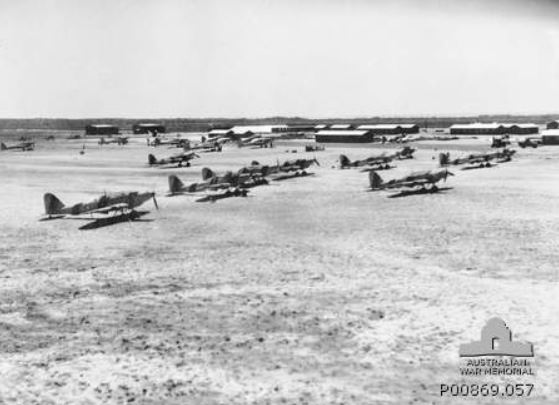Difference between revisions of "No. 3 Bombing & Air Gunnery School RAAF"
From Our Contribution
(→Trainees) |
|||
| (4 intermediate revisions by the same user not shown) | |||
| Line 6: | Line 6: | ||
| image = [[File:1_BAGS.jpg]] | | image = [[File:1_BAGS.jpg]] | ||
| − | | caption = | + | | caption = AWM Photo P00869.057 |
| image2 = [[File:1_BAGS_2.jpg]] | | image2 = [[File:1_BAGS_2.jpg]] | ||
| − | | caption2 = 1944 The gunnery range at No. 3 Bombing and Gunnery School RAAF showing the mobile target and gun turrets equipped with camera guns used by trainee air-gunners during their course. | + | | caption2 = 1944 The gunnery range at No. 3 Bombing and Gunnery School RAAF showing the mobile target and gun turrets equipped with camera guns used by trainee air-gunners. AWM photo VIC1979 during their course. |
}} | }} | ||
| Line 28: | Line 28: | ||
No. 3 Bombing and Gunnery School continued to operate fairly smoothly unti1 9 Dec 1943 when it became Air Gunnery School. The strength of aircraft for the unit at this time was: [[Fairey Battle]] 67, [[Avro Anson]] 24, [[Airspeed Oxford]] 33, Ryan five. and Moth Minor one. | No. 3 Bombing and Gunnery School continued to operate fairly smoothly unti1 9 Dec 1943 when it became Air Gunnery School. The strength of aircraft for the unit at this time was: [[Fairey Battle]] 67, [[Avro Anson]] 24, [[Airspeed Oxford]] 33, Ryan five. and Moth Minor one. | ||
| + | |||
| + | ===Ground Crew=== | ||
| + | * [[Vernon Wallace Marsh]] 4 May - 11 Sep 1942 | ||
| + | |||
===Trainees=== | ===Trainees=== | ||
| + | * [[Tom Shelley Griffiths]] 1 Jun - 4 Jul 1942 | ||
* [[Edward Watling]] 29 Jun - 28 Jul 1942 | * [[Edward Watling]] 29 Jun - 28 Jul 1942 | ||
| + | * [[Henry Frederick Wills]] 15 Sep - 9 Oct 1944 | ||
====Notes==== | ====Notes==== | ||
Content has come from ''Units of the Royal Australian Air Force - A Concise History - Volume 8 Training Units'' - Australian Government Publishing Service - 1995 | Content has come from ''Units of the Royal Australian Air Force - A Concise History - Volume 8 Training Units'' - Australian Government Publishing Service - 1995 | ||
Latest revision as of 02:12, 18 February 2024
Brief History
On 30 Dec 1941 the advanced party for the No. 3 Bombing & Gunnery School arrived at West Sale in Victoria, with the unit forming over January 1942. With the airfield little other than a runway and early construction of the buildings. Water had to be carted, and there were no sanitary arrangements.
The School was formed to carry out the function of completing the training of air gunners with a course of instruction in gunnery, and to train air observers in bombinng and gunnery. The unit's first aircraft, a Fairey Battle, arrived on 2 Feb 1942 from No. 1 Aircraft Park RAAF. Training commenced on 8 Mar 1942 with 43 trainees arriving from Mount Gambier. A group of Americans were fortunate that the unit was operational when on 13 Feb 1942, 14 Americans and their Kittyhawk aircraft were forced to land at West Sale after becoming lost while travelling from the north down to Laverton.
The first fatality at the School occurred in the first week of training when an aircraft dived into Glen Maggie Weir near Muddra on 14 March 1942. This accident followed an emergency landing at the aerodrome the day before due to engine trouble. The aircraft were to cause the same difficulties for 3 Bombing and Gunnery School as for the other two bombing and gunnery schools. The casualty rate could actually have been a lot worse than it was. Normally in an aircraft accident, both the pilot and crew (or trainees) would have
been killed. But on several occasions the crew were able to avoid death either because the pilot sacrificed himself in trying to land the aircraft, or because the trainees were able to parachute out of the aircraft. On those occasions a number of injuries were sustained by the surviving aircrew and trainees.
No. 3 Bombing and Gunnery School continued to operate fairly smoothly unti1 9 Dec 1943 when it became Air Gunnery School. The strength of aircraft for the unit at this time was: Fairey Battle 67, Avro Anson 24, Airspeed Oxford 33, Ryan five. and Moth Minor one.
Ground Crew
- Vernon Wallace Marsh 4 May - 11 Sep 1942
Trainees
- Tom Shelley Griffiths 1 Jun - 4 Jul 1942
- Edward Watling 29 Jun - 28 Jul 1942
- Henry Frederick Wills 15 Sep - 9 Oct 1944
Notes
Content has come from Units of the Royal Australian Air Force - A Concise History - Volume 8 Training Units - Australian Government Publishing Service - 1995

